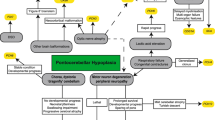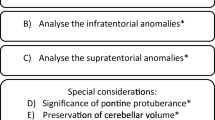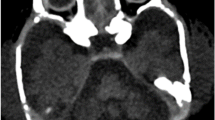Abstract
The term Pontocerebellar Hypoplasia (PCH) was initially used to designate a heterogeneous group of fetal-onset genetic neurodegenerative disorders. As a descriptive term, PCH refers to pons and cerebellum of reduced volume. In addition to the classic PCH types described in OMIM, many other disorders can result in a similar imaging appearance. This study aims to review imaging, clinical and genetic features and underlying etiologies of a cohort of children with PCH on imaging. We systematically reviewed brain images and clinical charts of 38 patients with radiologic evidence of PCH. Our cohort included 21 males and 17 females, with ages ranging between 8 days to 15 years. All individuals had pons and cerebellar vermis hypoplasia, and 63% had cerebellar hemisphere hypoplasia. Supratentorial anomalies were found in 71%. An underlying etiology was identified in 68% and included chromosomal (21%), monogenic (34%) and acquired (13%) causes. Only one patient had pathogenic variants in an OMIM listed PCH gene. Outcomes were poor regardless of etiology, though no one had regression. Approximately one third of patients deceased at a median age of 8 months. All individuals had global developmental delay, 50% were non-verbal, 64% were non-ambulatory and 45% required gastrostomy feeding. This cohort demonstrates that radiologic PCH has heterogenous etiologies and the “classic” OMIM-listed PCH genes underlie only a minority of cases. Broad genetic testing, including chromosomal microarray and exome or multigene panels, is recommended in individuals with PCH-like imaging appearance. Our results strongly suggest that the term PCH should be used to designate radiologic findings, and not to imply neurogenerative disorders.



Similar content being viewed by others
Data Availability
Data sharing on request from authors.
References
Barth PG, Vrensen GF, Uylings HB, Oorthuys JW, Stam FC. Inherited syndrome of microcephaly, dyskinesia and pontocerebellar hypoplasia: a systemic atrophy with early onset. J Neurol Sci. 1990;97:25–42.
Barth PG. Pontocerebellar hypoplasias. An overview of a group of inherited neurodegenerative disorders with fetal onset. Brain Dev. 1993;15:411–22.
Coolen M, Altin N, Rajamani K, Pereira E, Siquier-Pernet K, Puig Lombardi E, et al. Recessive PRDM13 mutations cause fatal perinatal brainstem dysfunction with cerebellar hypoplasia and disrupt Purkinje cell differentiation. Am J Hum Genet. 2022;109:909–27.
Doherty D, Millen KJ, Barkovich AJ. Midbrain and hindbrain malformations: advances in clinical diagnosis, imaging, and genetics. Lancet Neurol. 2013;12:381–93.
Severino M, Huisman TAGM. Posterior Fossa Malformations. Neuroimaging Clin N Am. 2019;29:367–83.
Rüsch CT, Bölsterli BK, Kottke R, Steinfeld R, Boltshauser E. Pontocerebellar Hypoplasia: a Pattern Recognition Approach. Cerebellum Lond Engl. 2020;19:569–82.
Scola E, Ganau M, Robinson R, Cleary M, De Cocker LJL, Mankad K, et al. Neuroradiological findings in three cases of pontocerebellar hypoplasia type 9 due to AMPD2 mutation: typical MRI appearances and pearls for differential diagnosis. Quant Imaging Med Surg. 2019;9:1966–72.
Bosemani T, Orman G, Boltshauser E, Tekes A, Huisman TAGM, Poretti A. Congenital abnormalities of the posterior fossa. Radiogr Rev Publ Radiol Soc N Am Inc. 2015;35:200–20.
Zafeiriou DI, Ververi A, Anastasiou A, Soubasi V, Vargiami E. Pontocerebellar hypoplasia in extreme prematurity: clinical and neuroimaging findings. Pediatr Neurol. 2013;48:48–51.
Jandeaux C, Kuchcinski G, Ternynck C, Riquet A, Leclerc X, Pruvo J-P, et al. Biometry of the Cerebellar Vermis and Brain Stem in Children: MR Imaging Reference Data from Measurements in 718 Children. AJNR Am J Neuroradiol. 2019;40:1835–41.
Sener RN. Cerebellar agenesis versus vanishing cerebellum in Chiari II malformation. Comput Med Imaging Graph Off J Comput Med Imaging Soc. 1995;19:491–4.
Boltshauser E, Schneider J, Kollias S, Waibel P, Weissert M. Vanishing cerebellum in myelomeningocoele. Eur J Paediatr Neurol EJPN Off J Eur Paediatr Neurol Soc. 2002;6:109–13.
Chidambaranathan N, Reddy S. Chiari malformation type II with vanishing cerebellum. Indian Pediatr. 2006;43:920–2.
Accogli A, Russell L, Sébire G, Rivière J-B, St-Onge J, Addour-Boudrahem N, et al. Pathogenic variants in AIMP1 cause pontocerebellar hypoplasia. Neurogenetics. 2019;20:103–8.
Yigazu P, Kalra V, Altinok D. Brainstem disconnection in a late preterm neonate with classic features of fetal alcohol syndrome. Pediatr Neurol. 2014;51:745–6.
Duffield C, Jocson J, Wootton-Gorges SL. Brainstem disconnection. Pediatr Radiol. 2009;39:1357–60.
Marin-Valencia I, Gerondopoulos A, Zaki MS, Ben-Omran T, Almureikhi M, Demir E, et al. Homozygous Mutations in TBC1D23 Lead to a Non-degenerative Form of Pontocerebellar Hypoplasia. Am J Hum Genet. 2017;101:441–50.
Mochida GH, Ganesh VS, de Michelena MI, Dias H, Atabay KD, Kathrein KL, et al. CHMP1A encodes an essential regulator of BMI1-INK4A in cerebellar development. Nat Genet. 2012;44:1260–4.
Budde BS, Namavar Y, Barth PG, Poll-The BT, Nürnberg G, Becker C, et al. tRNA splicing endonuclease mutations cause pontocerebellar hypoplasia. Nat Genet. 2008;40:1113–8.
Cassandrini D, Biancheri R, Tessa A, Di Rocco M, Di Capua M, Bruno C, et al. Pontocerebellar hypoplasia: clinical, pathologic, and genetic studies. Neurology. 2010;75:1459–64.
Namavar Y, Barth PG, Kasher PR, van Ruissen F, Brockmann K, Bernert G, et al. Clinical, neuroradiological and genetic findings in pontocerebellar hypoplasia. Brain J Neurol. 2011;134:143–56.
Passemard S, Titomanlio L, Elmaleh M, Afenjar A, Alessandri J-L, Andria G, et al. Expanding the clinical and neuroradiologic phenotype of primary microcephaly due to ASPM mutations. Neurology. 2009;73:962–9.
Del Giudice E, Macca M, Imperati F, D’Amico A, Parent P, Pasquier L, et al. CNS involvement in OFD1 syndrome: a clinical, molecular, and neuroimaging study. Orphanet J Rare Dis. 2014;9:74.
Accogli A, Guerrero K, D’Agostino MD, Tran L, Cieuta-Walti C, Thiffault I, et al. Biallelic Loss-of-Function Variants in AIMP1 Cause a Rare Neurodegenerative Disease. J Child Neurol. 2019;34:74–80.
Gómez-Santos E, Lloreda-García JM, Fernández-Fructuoso JR, Martínez-Ferrández C, Leante-Castellanos JL, Fuentes-Gutiérrez C. Neonatal Marshall-Smith syndrome. Clin Dysmorphol. 2014;23:42–4.
Travan L, Oretti C, Zennaro F, Demarini S. Marshall-Smith syndrome and septo-optic dysplasia: an unreported association. Am J Med Genet A. 2008;146A:2138–40.
Summers DA, Cooper HA, Butler MG. Marshall-Smith syndrome: case report of a newborn male and review of the literature. Clin Dysmorphol. 1999;8:207–10.
Nowaczyk MJM, Irons MB. Smith-Lemli-Opitz syndrome: phenotype, natural history, and epidemiology. Am J Med Genet C Semin Med Genet. 2012;160C:250–62.
Lee RWY, Conley SK, Gropman A, Porter FD, Baker EH. Brain magnetic resonance imaging findings in Smith-Lemli-Opitz syndrome. Am J Med Genet A. 2013;161A:2407–19.
Inagaki M, Ando Y, Mito T, Ieshima A, Ohtani K, Takashima S, et al. Comparison of brain imaging and neuropathology in cases of trisomy 18 and 13. Neuroradiology. 1987;29:474–9.
Pinter JD, Eliez S, Schmitt JE, Capone GT, Reiss AL. Neuroanatomy of Down’s syndrome: a high-resolution MRI study. Am J Psychiatry. 2001;158:1659–65.
Erenel H, Madazli R. Pons Anteroposterior and Cerebellar Vermis Craniocaudal Diameters in Fetuses With Down Syndrome. J Ultrasound Med Off J Am Inst Ultrasound Med. 2021;40:123–8.
Tamraz J, Rethoré MO, Lejeune J, Outin C, Goepel R, Stievenart JL, et al. Brain morphometry using MRI in Cri-du-Chat Syndrome. Report of seven cases with review of the literature. Ann Genet. 1993;36:75–87.
Pejcic L, Stankovic T, Ratkovic-Jankovic M, Vasic K, Nikolic I. Clinical manifestations in trisomy 9 mosaicism. Turk J Pediatr. 2018;60:729–34.
Messerschmidt A, Brugger PC, Boltshauser E, Zoder G, Sterniste W, Birnbacher R, et al. Disruption of cerebellar development: potential complication of extreme prematurity. AJNR Am J Neuroradiol. 2005;26:1659–67.
Johnsen SD, Bodensteiner JB, Lotze TE. Frequency and nature of cerebellar injury in the extremely premature survivor with cerebral palsy. J Child Neurol. 2005;20:60–4.
Bilge S, Mert GG, Hergüner Ö, Özcanyüz D, Bozdoğan ST, Kaya Ö, et al. Clinical, radiological, and genetic variation in pontocerebellar hypoplasia disorder and our clinical experience. Ital J Pediatr. 2022;48:169.
Nuovo S, Micalizzi A, Romaniello R, Arrigoni F, Ginevrino M, Casella A, et al. Refining the mutational spectrum and gene-phenotype correlates in pontocerebellar hypoplasia: results of a multicentric study. J Med Genet. 2022;59:399–409.
Valence S, Garel C, Barth M, Toutain A, Paris C, Amsallem D, et al. RELN and VLDLR mutations underlie two distinguishable clinico-radiological phenotypes. Clin Genet. 2016;90:545–9.
Cotes C, Bonfante E, Lazor J, Jadhav S, Caldas M, Swischuk L, et al. Congenital basis of posterior fossa anomalies. Neuroradiol J. 2015;28:238–53.
Takanashi J, Arai H, Nabatame S, Hirai S, Hayashi S, Inazawa J, et al. Neuroradiologic features of CASK mutations. AJNR Am J Neuroradiol. 2010;31:1619–22.
Hayashi S, Uehara DT, Tanimoto K, Mizuno S, Chinen Y, Fukumura S, et al. Comprehensive investigation of CASK mutations and other genetic etiologies in 41 patients with intellectual disability and microcephaly with pontine and cerebellar hypoplasia (MICPCH). PLoS ONE. 2017;12:e0181791.
Acknowledgements
M Srour holds a salary award from the Fonds de Recherche de Santé Quebec.
Funding
The authors did not receive support from any organization for the submitted work.
Author information
Authors and Affiliations
Contributions
Conceptualization: Myriam Srour, Rohaya Zakaria. First draft of the manuscript: Rohaya Zakaria and Maisa Malta. Data collection: Rohaya Zakaria, Maisa Malta, Felixe Pelletier. Imaging review: Christine Saint-Martin. Supervision: Myriam Srour, Elana Pinchefsky. All authors contributed to critical feedback, revision, and final approval of the manuscript.
Corresponding author
Ethics declarations
Ethical Approval
This study was approved by our institutional research ethics boards (McGill University Health Center MP-2021–6580; Centre Hospitalier Universitaire Sainte Justine MEO-37–2021-2915). Our REB waived the requirement for signed patient consent as the study does not include any identifiable images or information.
Competing Interests
The authors declare that they have no competing interests.
Additional information
Publisher's Note
Springer Nature remains neutral with regard to jurisdictional claims in published maps and institutional affiliations.
Rohaya Binti Mohamad Zakaria and Maisa Malta have equal contribution as co-first authors.
Supplementary Information
Below is the link to the electronic supplementary material.
Rights and permissions
Springer Nature or its licensor (e.g. a society or other partner) holds exclusive rights to this article under a publishing agreement with the author(s) or other rightsholder(s); author self-archiving of the accepted manuscript version of this article is solely governed by the terms of such publishing agreement and applicable law.
About this article
Cite this article
Zakaria, R.B.M., Malta, M., Pelletier, F. et al. Classic “PCH” Genes are a Rare Cause of Radiologic Pontocerebellar Hypoplasia. Cerebellum 23, 418–430 (2024). https://doi.org/10.1007/s12311-023-01544-2
Accepted:
Published:
Issue Date:
DOI: https://doi.org/10.1007/s12311-023-01544-2




